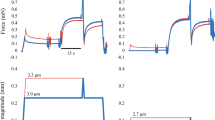Summary
The effect of shortening velocity on the reduction in work output, energy consumption and efficiency during repetitive contractions has been determined in rat extensor digitorum longus muscle. Muscles in situ (with occluded blood flow, 37° C) were stimulated to perform 40 successive contractions (at 4 Hz) with a total duration of the exercise period of 10 s and shortening velocities of either 25, 50 or 75 mm·s−1 (whole muscle-tendon complex). Care was taken that work output during the shortening phase of the first contraction was the same for the different velocities used. Total work output of the 40 contractions was not significantly different between the three groups with different shortening velocities; nor was there a significant difference in the high-energy phosphate consumption over this 10-s exercise period. However, when the ratio of total work output and total energy consumption was calculated a significantly higher efficiency (25–30% in comparison with the efficiency of the other two velocities) was found with the shortening velocity of 50 mm · s−1. There was no significant difference in efficiency between shortening velocities of 25 and 75 mm · s−1. This suggests that with this protocol efficiency showed a velocity-dependent pattern that may have the same shape as the power/velocity curve. Whereas total work output during the 10-s exercise period was not significantly different between the velocities studied, the time course of the changes in work output was quite different. With shortening velocities of 50 and 75 mm · s−1 work output initially increased by maximally 6% and 12% respectively in contrast to a steady level in the contractions with a velocity of 25 mm · s−1. Between the 20th and 30th contractions, however, work output steadily decreased by approximately 2% each contraction with shortening velocities of 25 and 50 mm · s−1. In contrast, there was a much faster drop in work output at 75 mm · s−1, averaging 6% each contraction over the same period. These data have been discussed with respect to the mechanisms of fatigue and potentiation in relation to fibre-type distribution.
Similar content being viewed by others
References
Ariano MA, Armstrong RB, Edgerton EV (1973) Hindlimb muscle fiber populations of five mammals. J Histochem Cytochem 21:51–55
Benedict FG, Cathcart EP (1913) Muscular work: a metabolic study with special reference to the efficiency of the human body as a machine. Carnegie Inst Publ no. 187, Washington, DC
Berden JA, Haan A de, Haan EJ de, Doorn JE van, Hartog AF, Westra HG (1986) Has IMP a regulatory role during fatiguing contraction? IMP-binding sites on the myosin complex of rat muscle. J Physiol (Lond) 381:85P
Cooke R, Franks K, Luciani GB, Pate E (1988) The inhibition of rabbit skeletal muscle contraction by hydrogen ions and phosphate. J Physiol (Lond) 395:77–97
Doorn JE van, Goormachtig PFJ, Haan A de (1989) The influence of perchloric acid on ion-pair High Performance Liquid Chromatography of nucleotides. J Chromat 496:441–449
Enoka RM, Rankin LL, Stuart DG, Volz KA (1989) Fatigability of rat hindlimb muscle: associations between electromyogram and force during a fatigue test. J Physiol (Lond) 408:251–270
Gaesser GA, Brooks GA (1975) Muscular efficiency during steady-rate exercise: effects of speed and work rate. J Appl Physiol 38:1132–1139
Haan A de, Hollander AP, Sargeant AJ (1988a) A computer-controlled system for isovelocity measurements of in situ rat skeletal muscle. J Physiol (Lond) 396:77P
Haan A de, Doorn JE van, Sargeant AJ (1988b) Age-related changes in power output during repetitive contractions of rat medial gastrocnemius muscle. Pflügers Arch 412:665–667
Hill AV (1922) The maximum work and mechanical efficiency of human muscles and their most economical speed. J Physiol (Lond) 56:19–30
Kushmerick MJ, Davies RE (1969) The chemical energetics of muscle contraction. II. The chemistry, efficiency and power of maximally working sartorius muscles. Proc R Soc Lond [Biol] 174:315–353
Lupton H (1923) An analysis of the effects of speed on the mechanical efficiency of human muscular movement. J Physiol (Lond) 57:337–439
Manning DR, Stull JT (1982) Myosin light chain phosphorylation-dephosphorylation in mammalian skeletal muscle. Am J Physiol 242:C234–C241
Meyer RA, Dudley GA, Terjung RL (1980) Amonia and IMP in different skeletal muscle fibers after exercise in rats. J Appl Physiol 49:1037–1041
Moore RL, Stull JT (1984) Myosin light chain phosphorylation in fast and slow skeletal muscles in situ. Am J Physiol 247: C462-C471
Pemrick SM (1980) The phosphorylated L2 light chain of skeletal myosin is a modifier of the actomyosin ATPase. J Biol Chem 255:8836–8841
Sahlin K, Edström L, Sjöholm H, Hultman E (1981) Effects of lactic acid accumulation and ATP decrease on muscle tension and relaxation. Am J Physiol 240:C121-C126
Stainsby WN, Gladden LB, Barclay JK, Wilson BA (1980) Exercise efficiency: validity of base-line subtractions. J Appl Physiol 48:518–522
Sweeney HL, Kushmerick MJ, Mabuchi K, Gergely J, Sréter FA (1986) Velocity of shortening and myosin isozymes in two types of rabbit fast-twitch muscle fibers. Am J Physiol 251:C431-C434
Author information
Authors and Affiliations
Rights and permissions
About this article
Cite this article
Lodder, M.A.N., de Haan, A. & Sargeant, A.J. Effect of shortening velocity on work output and energy cost during repeated contractions of the rat EDL muscle. Europ. J. Appl. Physiol. 62, 430–435 (1991). https://doi.org/10.1007/BF00626616
Accepted:
Issue Date:
DOI: https://doi.org/10.1007/BF00626616




